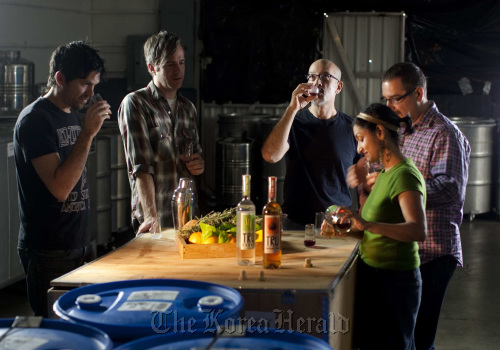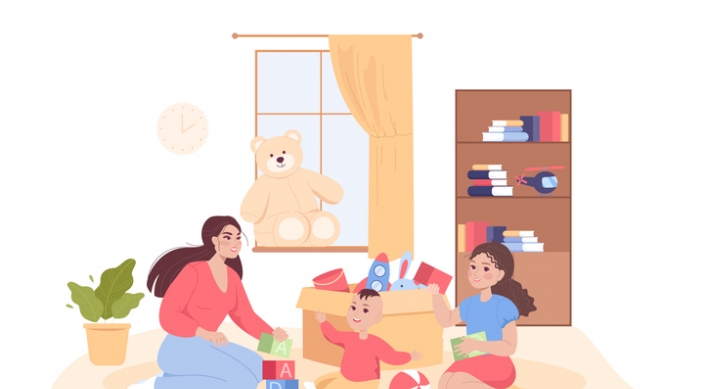The air outside GreenBar Collective craft distillery in Monrovia, California, is getting warm, but it still crackles with the crispness of fall. Inside the bright, white warehouse, two employees bottle fresh apple bitters while Keith Taylor, the bar manager for sprawling Echo Park restaurant Mohawk Bend, chats with GreenBar’s founders and master distillers, Melkon Khosrovian and Litty Mathew. They stand beside a silver tank of ruby red hibiscus liqueur that Taylor uses to make a limoncello-based drink called the Arturo Bandini. GreenBar is happy to make time for Taylor as he’s one of its most important customers: He has created a robust cocktail program using only California spirits.
At the moment, Taylor is contemplating the new apple bitters. “Got any ideas?” asks Mohawk Bend floor manager, Anthony Pecos. Taylor nods.
“Fall is about apples,” Khosrovian interjects. “I’m thinking gin, muddled celery, muddled or fresh-pressed apple juice and apple bitters.”
The conversation takes off from there. More booze and ingredient combinations are discussed, and a few winning ideas emerge that Taylor plans to experiment with later that week. Experimenting is a large part of his job, because Mohawk Bend stocks more than 100 different bottles of alcohol, all made by small-batch distilleries in California, many of which don’t lend themselves to traditional cocktail recipes. In L.A., it’s a one-of-a-kind cocktail program, and its success speaks to the growing richness of California’s craft distilleries, which, according to the American Distilling Institute, are the most numerous of any state in the nation, with a current total of 28, up from around 10 just seven years ago.
A large number of those distilleries are clustered in Northern California, where wineries and breweries act as feeder industries. In Los Angeles, where such businesses are scarce, GreenBar Collective stands as the sole craft distillery and claims to make the world’s largest collection of organic liquor. In a couple of months, it plans to ramp up its presence in the city by moving to a new facility in downtown Los Angeles, at 8th and Santa Fe streets. The move will enable it to further strengthen relationships with its local buyers, including restaurants such as Bottega Louie, Akasha, BLD, Border Grill and Chaya, which results in a rare opportunity to collaborate on outside-the-box cocktail ideas using its vodka, gin, rum, tequila and liqueurs.
“When Keith and others like him visit the distillery, we are breaking down those walls of mystery,” Khosrovian says. “To learn how the spirits they use are made, is essential to their trade.”
At the moment, Taylor is contemplating the new apple bitters. “Got any ideas?” asks Mohawk Bend floor manager, Anthony Pecos. Taylor nods.
“Fall is about apples,” Khosrovian interjects. “I’m thinking gin, muddled celery, muddled or fresh-pressed apple juice and apple bitters.”
The conversation takes off from there. More booze and ingredient combinations are discussed, and a few winning ideas emerge that Taylor plans to experiment with later that week. Experimenting is a large part of his job, because Mohawk Bend stocks more than 100 different bottles of alcohol, all made by small-batch distilleries in California, many of which don’t lend themselves to traditional cocktail recipes. In L.A., it’s a one-of-a-kind cocktail program, and its success speaks to the growing richness of California’s craft distilleries, which, according to the American Distilling Institute, are the most numerous of any state in the nation, with a current total of 28, up from around 10 just seven years ago.
A large number of those distilleries are clustered in Northern California, where wineries and breweries act as feeder industries. In Los Angeles, where such businesses are scarce, GreenBar Collective stands as the sole craft distillery and claims to make the world’s largest collection of organic liquor. In a couple of months, it plans to ramp up its presence in the city by moving to a new facility in downtown Los Angeles, at 8th and Santa Fe streets. The move will enable it to further strengthen relationships with its local buyers, including restaurants such as Bottega Louie, Akasha, BLD, Border Grill and Chaya, which results in a rare opportunity to collaborate on outside-the-box cocktail ideas using its vodka, gin, rum, tequila and liqueurs.
“When Keith and others like him visit the distillery, we are breaking down those walls of mystery,” Khosrovian says. “To learn how the spirits they use are made, is essential to their trade.”

Taylor is an enthusiastic student. Beginning a year ago at Mohawk Bend owner Tony Yanow’s behest, he embarked on a tour of as many California distilleries as possible. Along the way he became friends with Marko Karakasevic, the 13th-generation distiller at Northern California’s famed Charbay distillery (Charbay is Mohawk Bend’s house vodka); he got to know a Vietnam War vet named Dave Classick at Essential Spirits in Mountain View, Calif., who makes a complex rum with Hawaiian molasses and what Taylor believes is the only bierschnaps made in the U.S.; and he discovered why Temecula, Calif., distillery JB Wagoner’s attempt to make tequila in California and call it “Temequila” didn’t fly with the Mexican government. They now call it a “blue agave spirit.”
Because technically tequila must be produced in Mexico, Mohawk Bend doesn’t carry it. The same goes for Scotch. And if an ingredient is essential to a drink but isn’t made in California, as is the case with tonic water, Mohawk Bend chef Randal St. Clair will make it himself.
The bar also gets the bulk of its bitters from a relatively new company called Miracle Mile Bitters, which was created by a self-proclaimed “cocktail geek” named Louis Anderman, who sublets a space at GreenBar for his research and development lab.
Anderman’s bitters, including chocolate-chile, yuzu and sour cherry, are carried in about 30 L.A. bars such as Tar Pit, Harvard & Stone and Little Dom’s.
“The support from the L.A. community has been incredible,” Anderman says. “I’ve gotten to know so many bartenders. I consider them creative collaborators, although I have but one liver to give for my art.”
In Los Angeles, where the dining scene is gripped by a local, organic and sustainable fever, it seems only natural that spirits would follow suit. After all, most of the city’s top mixologists, including Zahra Bates and Julian Cox, began hand-crafting cocktails with high-quality ingredients after realizing the disconnect between serving an artificial Apple Pucker martini beside a plate of fresh farmers market food. Take that thought process one step further and you naturally arrive at using craft distilleries as your sole source of liquor, Cox says.
Cox, who created the beverage programs at Rivera, Playa and Picca, is now working on the program for Short Order, Nancy Silverton and the late Amy Pressman’s new gourmet burger concept in the Original Farmers Market.
“They’ve created an all-American burger with local grass-fed beef, cheddar and pickles, so we are only using American micro-distillers for our program,” Cox says. “We’ll have a ton of California brands in the mix.” Cox, however, doesn’t think that California is quite ready to solely support the type of spirits program that he wants to run, although he does believe that it’s on its way.
“There has been a lot of growth in California over the past five years,” Cox says, “and we’re going to see it more and more.”
Indeed, consumer expectations are the biggest challenge with crafting a California-only cocktail program, Taylor says.
“People come in and they want a Belvedere martini, a Bombay and tonic or a Jim Beam and Coke,” he says. “But when we explain what we are doing, only 1 in 30 will say, ‘That’s a drag.’”
The unpredictable nature of craft distilleries also makes for an unpredictable booze program, but often in a serendipitous way, Yanow says.
“Our program is a living, moving organism, because sometimes we get spirits which become suddenly unavailable and we have to adapt,” he says, using as an example the time that Taylor put a drink on the menu featuring Charbay’s Double & Twisted whiskey. The bar proceeded to go through its entire supply in three weeks.
“Then it went extinct,” Taylor says, laughing. “It takes three to four years to make.”
When GreenBar moves to downtown L.A., it will begin making whiskey, Mathew says, and when it does, it will be remarkably different from other offerings in the market.
“When you don’t have that idea that you need to preserve tradition,” she says, “you break the rules.”
By Jessica Gelt
(Los Angeles Times)
(MCT Information Services)
-
Articles by Korea Herald








![[Today’s K-pop] BTS pop-up event to come to Seoul](http://res.heraldm.com/phpwas/restmb_idxmake.php?idx=644&simg=/content/image/2024/04/17/20240417050734_0.jpg&u=)
![[Graphic News] More Koreans say they plan long-distance trips this year](http://res.heraldm.com/phpwas/restmb_idxmake.php?idx=644&simg=/content/image/2024/04/17/20240417050828_0.gif&u=)







![[KH Explains] Hyundai's full hybrid edge to pay off amid slow transition to pure EVs](http://res.heraldm.com/phpwas/restmb_idxmake.php?idx=652&simg=/content/image/2024/04/18/20240418050645_0.jpg&u=20240419100350)

